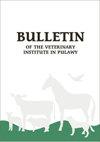Contamination of honey produced in the Republic of Kazakhstan with Clostridium botulinum
引用次数: 8
Abstract
Abstract The paper presents the first results of a study on the contamination of honey produced in the Republic of Kazakhstan with C. botulinum spores known to pose a potential infection threat to infants. During microbiological analysis, culturing methods with TPGY, Willis-Hobbs agar, FAA agar connected with PCR, sequencing, and a mouse bioassay were used. The C. botulinum contamination rate of honey was relatively low as determined, at 0.91%. Nonetheless, the potential danger of the bacteria to childrens’ health should not be neglected哈萨克斯坦共和国生产的蜂蜜被肉毒梭菌污染
摘要:本文介绍了哈萨克斯坦共和国生产的蜂蜜污染研究的第一个结果,已知肉毒杆菌孢子对婴儿构成潜在的感染威胁。在微生物学分析中,采用TPGY、Willis-Hobbs琼脂、FAA琼脂连接PCR、测序和小鼠生物测定的培养方法。经测定,蜂蜜的肉毒杆菌污染率较低,为0.91%。然而,细菌对儿童健康的潜在危险不应被忽视
本文章由计算机程序翻译,如有差异,请以英文原文为准。
求助全文
约1分钟内获得全文
求助全文

 求助内容:
求助内容: 应助结果提醒方式:
应助结果提醒方式:


